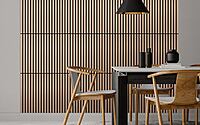Soundproofing With Style: The Benefits Of Wooden Acoustic Panels
Soundproofing walls with wooden acoustic panels is a growing trend in both the home and workplace. Not only can these panels lessen ambient noise, but they also improve the aesthetic appeal of a space.
The Blog will cover the advantages and qualities of wooden acoustic panels as well as their installation, maintenance, aesthetic considerations, and pricing. If you are thinking about installing wooden acoustic panels in your home or business, we will also provide you some advice.
History and Development Of Wooden Acoustic Panels
The use of acoustic wood panels for soundproofing dates back to the early 20th century and has evolved over time. They were first utilized in recording studios and were typically made of felt or cork.
Bamboo, plywood, and medium-density fiberboard (MDF) are only a few examples of the modern materials and designs used in acoustic panels made of wood. Besides being aesthetically pleasing and long-lasting, hardwood acoustic panels are also great at reducing noise levels.
Sound Absorption Properties
Wooden acoustic panels are effective because of their sound absorption properties, which lessen the quantity of ambient noise caused by sound reflections. Size, form, and material all play a role in how well wooden acoustic panels absorb noise.
For instance, bamboo is commonly used in high-end soundproofing systems due to its exceptional sound absorption qualities. The panels’ effectiveness to dampen noise is also affected by factors including their dimensions and geometry. Panels of varying sizes and shapes can be used to attenuate noise across a wide range of frequencies.
Installation Process For Wooden Acoustic Panels
Wooden acoustic panels can be mounted to a wall or ceiling, or they can be used on their own as free-standing furniture. Common installation methods entail screwing or adhering the panels to the wall.
Free-standing panels can be positioned anywhere in a room to focus on a specific region, while ceiling mounts are ideal for spaces with high ceilings. Wooden acoustic panels are typically easy to install and can be done by a do-it-yourself enthusiast with common household tools.
Maintenance Tips And Methods
Acoustic panels made of wood can be wiped down with a moist cloth when they get dusty. Abrasive cleaning products should be avoided as they can scratch the panels’ surface.
The durability of wooden acoustic panels is affected by a number of variables, including the quality of the wood, the surrounding conditions, and the frequency with which the panels are used. Wooden acoustic panels, in particular, are highly long-lasting and can be used for years with the right amount of care and upkeep.
Aesthetic Considerations
A wooden acoustic panel enhances a room’s soundproofing and decor to boot. They are available in a wide range of hues, materials, and designs to match any interior scheme.
Popular layout choices include diamond, chevron, and herringbone patterns with natural, stained, and painted finishes. Acoustic panels made of wood can be altered to fit any space and design scheme.
Cost Of Installation
Wooden acoustic panels range in price from around $100 to over $1,000, with many variables influencing the final tally. It’s true that bamboo panels are more expensive than other options, but they also offer superior sound absorption and a more organic aesthetic.
However, the costs can rise if panels are designed specifically for a client, or if they are made larger than standard sizes. On the other hand, wooden acoustic panels are often less expensive than alternative methods of soundproofing and may even pay for themselves over time.
Conclusion
Wooden acoustic panels, as stated previously, have many uses and benefits as a means of soundproofing a home or business. They are simple to set up and keep in good working order, and they can help lower the room’s ambient noise level without sacrificing the space’s aesthetic value. When compared to other methods of soundproofing, wooden acoustic panels are more affordable and can yield a higher return on investment.
Before installing wooden acoustic panels in your house or workplace, think about the room’s dimensions, the type of soundproofing you require, and the design of the panels you’d like to use. Wooden acoustic panels are an adaptable and aesthetically pleasing alternative for anyone wishing to increase the level of soundproofing in their home or workplace.
Wooden acoustic panels, whether made of bamboo, plywood, or medium-density fiberboard (MDF), can provide a number of advantages if installed and maintained correctly. When wanting to increase the acoustic quality of a room, wooden acoustic panels are a practical and aesthetically pleasing option.
- by Matt Watts
